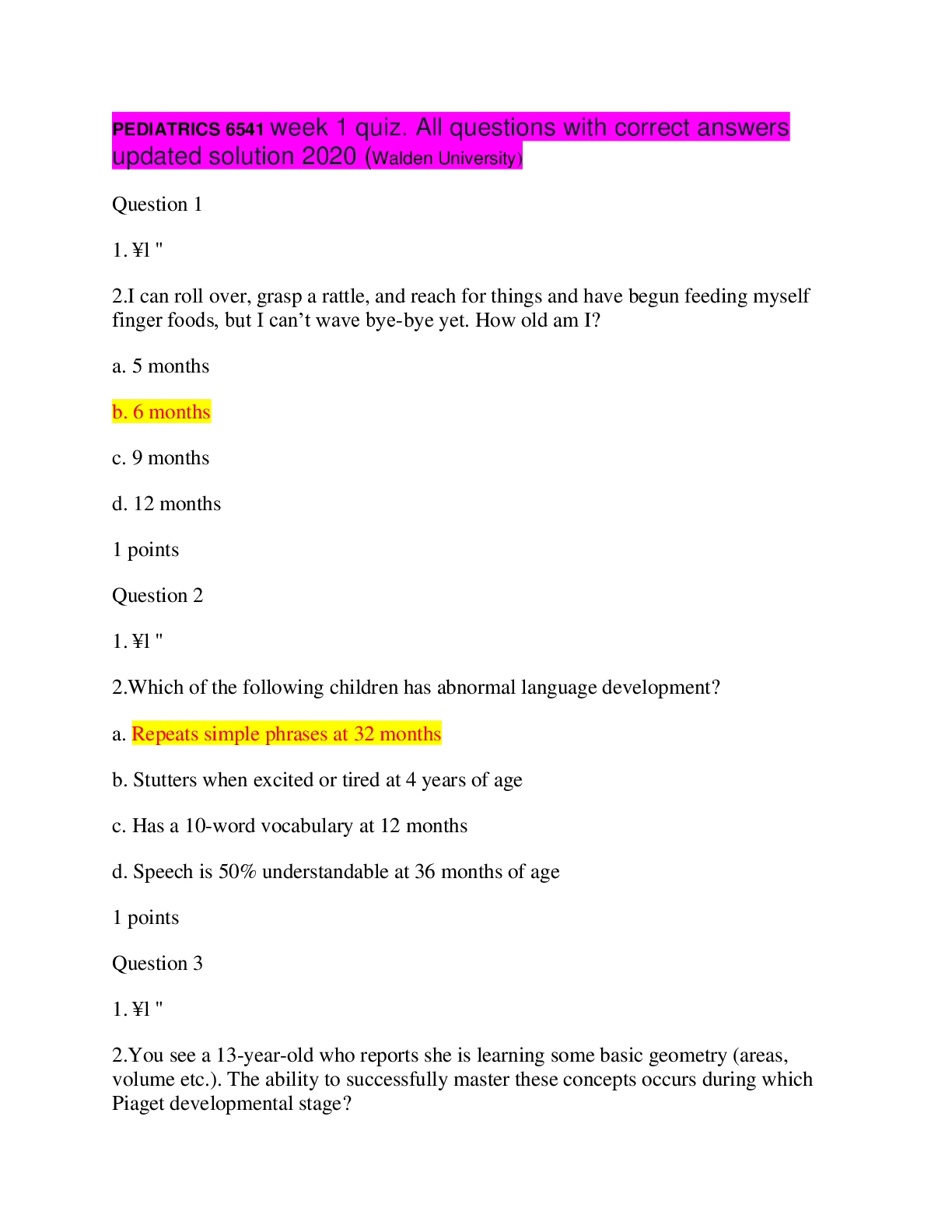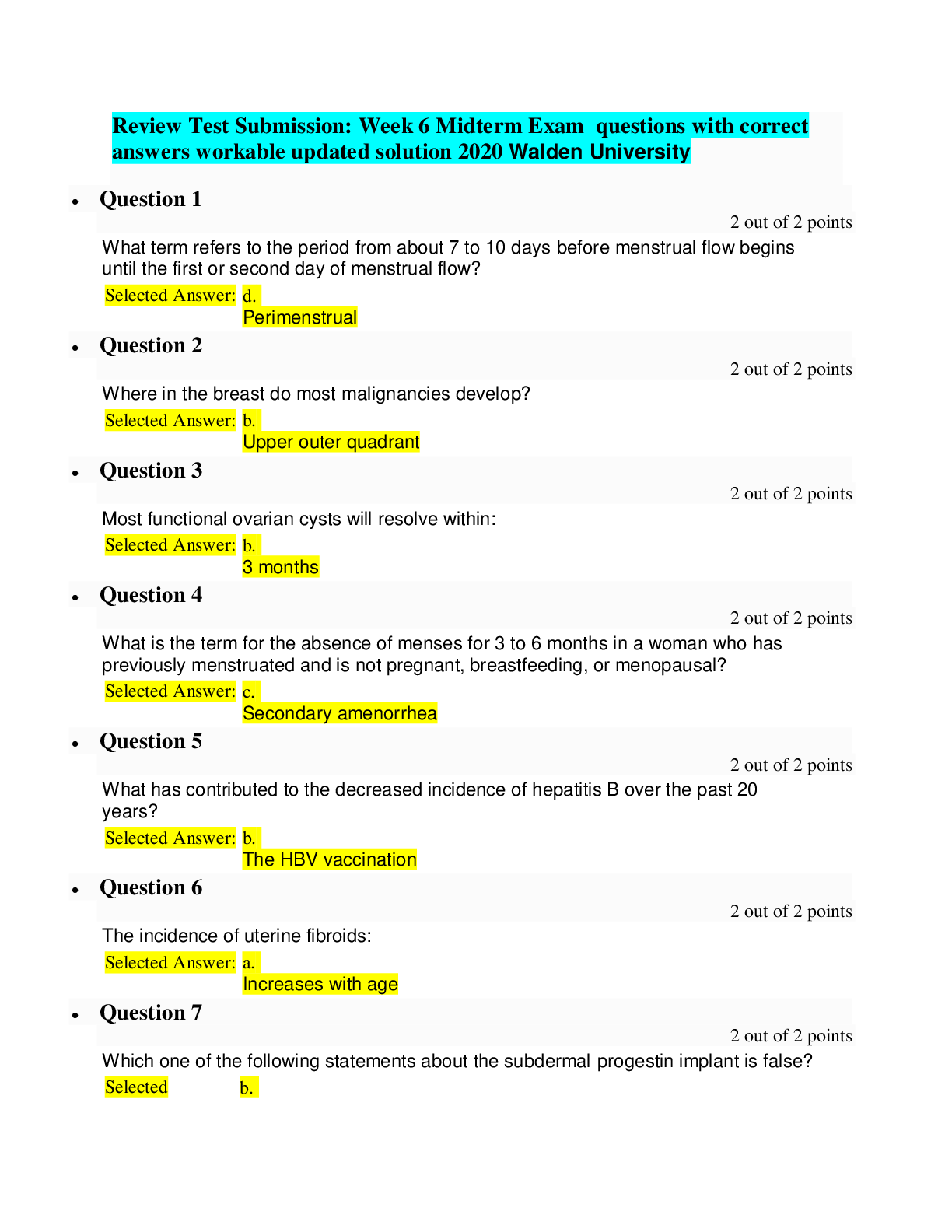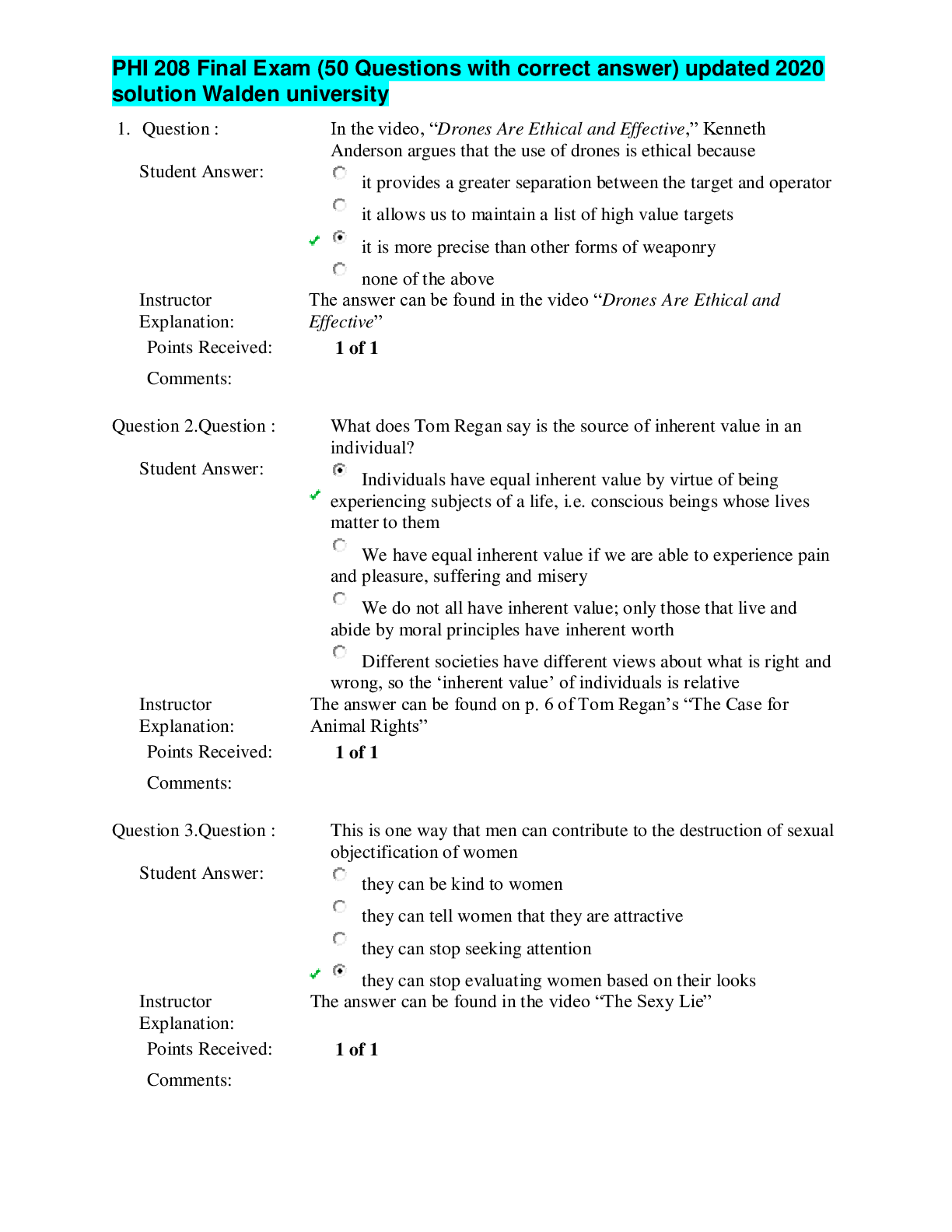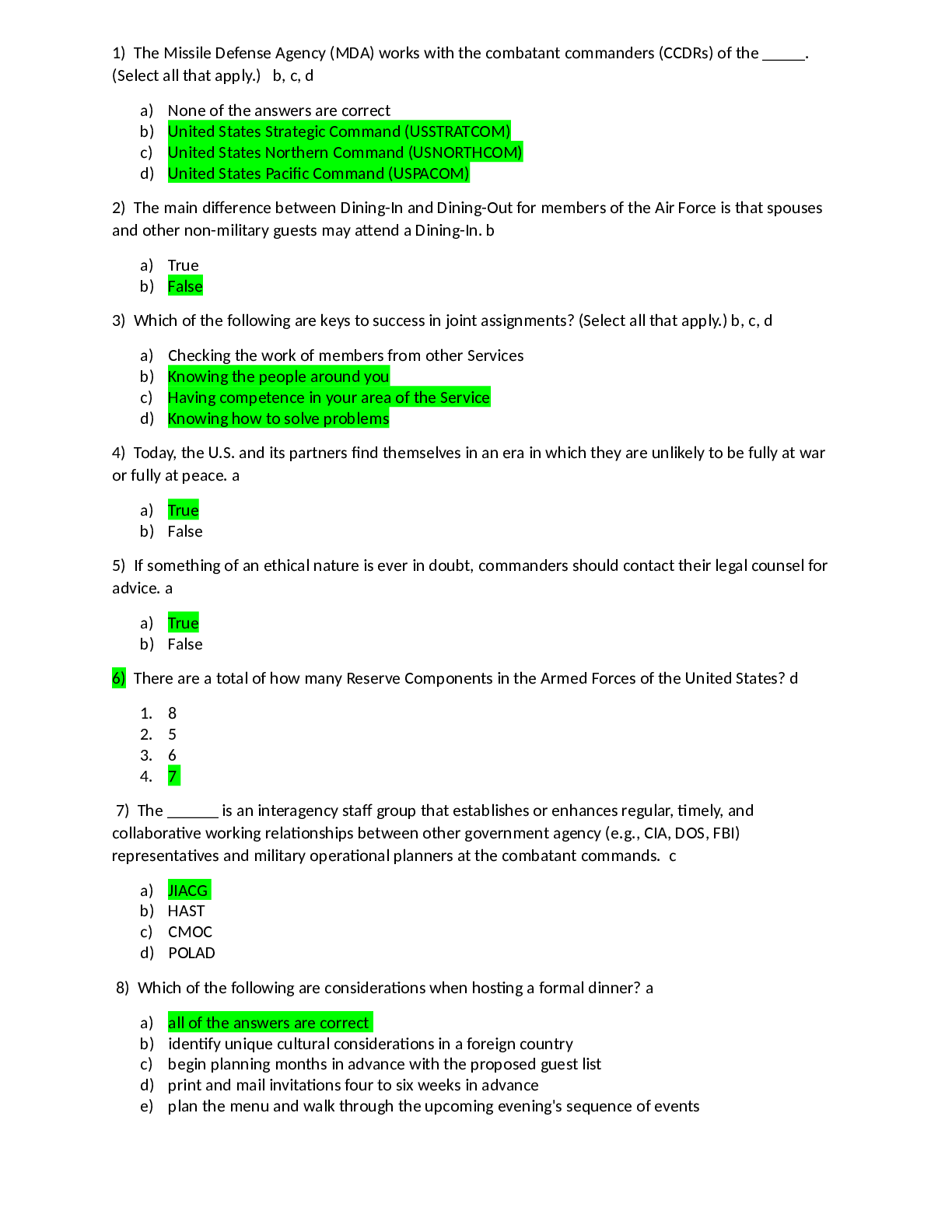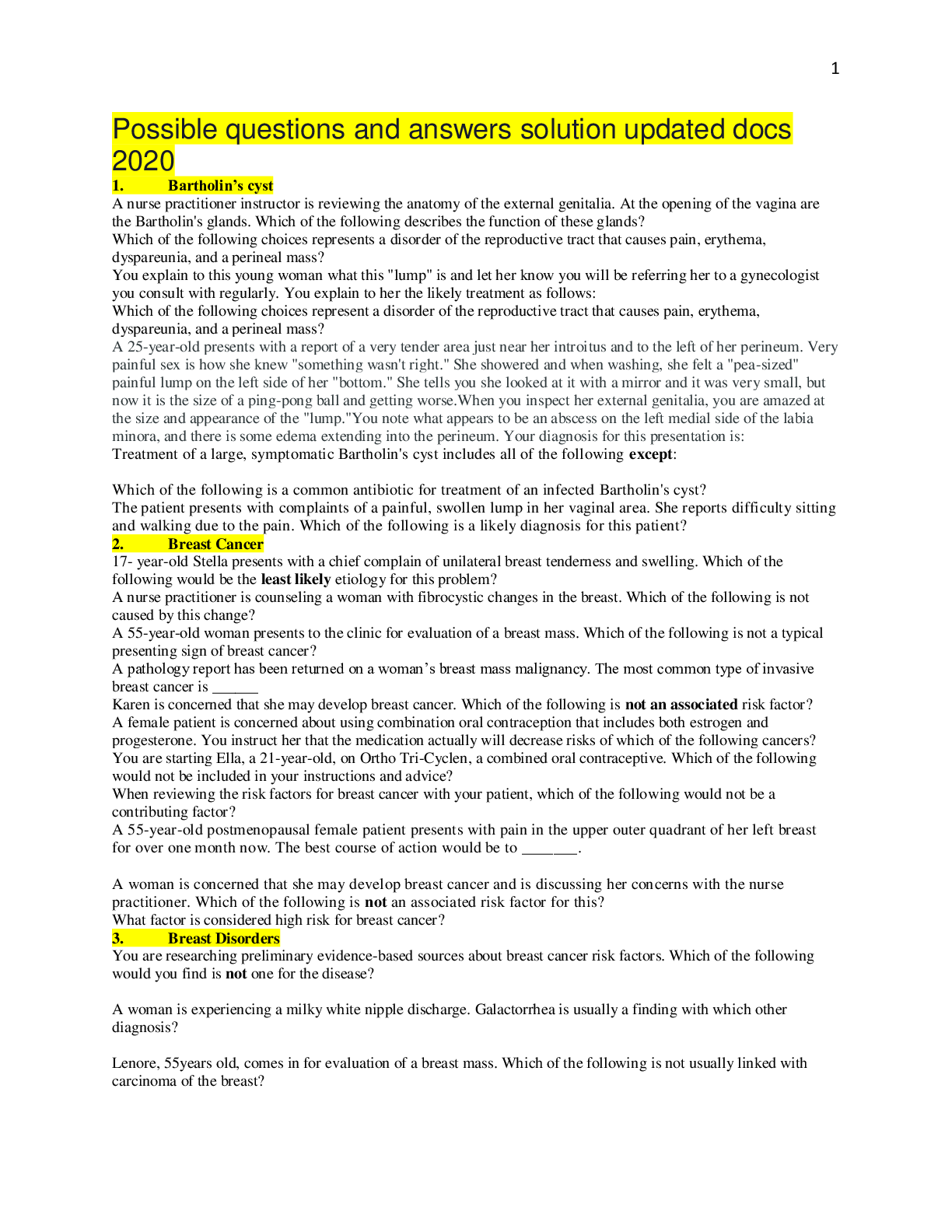*NURSING > QUESTIONS & ANSWERS > NURS 6640 midterm 3 Revision Questions With Correct Answers-GRADED A+ (All)
NURS 6640 midterm 3 Revision Questions With Correct Answers-GRADED A+
Document Content and Description Below
QUESTION 1 1. The PMHNP understands that anxiety and depression are two disorders in which their symptoms may overlap. When discussing this, you explain that the autonomic nervous system is activat... ed and further helps distinguish anxiety symptoms by making the following points: 2. A . “You may experience an elevated heart rate, constant worrying, and diarrhea.” B. “You may experience fear, sweating, and muscle tension.” C. “You may experience an elevated heart rate, the need to urinate, and fear.” D. “You may experience sleepiness, decreased blood pressure, and fear.” 1 points QUESTION 2 1. The PMHNP is working with a school-aged child who has been diagnosed with depression. The child has attended several sessions with the PMNHP, but recently presents with avoidant behavior by showing increased distress and being late to sessions. What approach does the PMHNP need to employ with the child to continue making therapeutic progress? D. All of the above 1 points QUESTION 3 1. After informing a prospective patient about limits of confidentiality, the patient consents to the “conditions” of confidentiality and signs an informed consent form. Several weeks later, a lawyer representing the patient’s spouse for a court case, asks the PMHNP for the disclosure of information about the patient. The PMHNP should: 2. C. Limit disclosure to the extent legally possible 1 points QUESTION 4 1. In your office, you see a 58-year-old patient with PTSD who reports having nightmares, making it impossible for her to sleep. What recommendations based on principles of sleep hygiene will the PMHNP make? C. Avoid watching television or reading2 in bed 1 points QUESTION 5 1. An 11-year-old patient has been exhibiting low self-esteem at school and acting out. According to Maslow’s hierarchy of needs, which of the following questions would best be addressed first by the PMHNP? 2. C. “Is Joel getting enough sleep at home?” 1 points QUESTION 6 1. A patient named Steve is seeking therapy to get help with his home situation, stating that he has been stressed since his mother-in-law moved into the house. What can the PMHNP do to assist the patient in constructing a narrative? 2. B. Elicit details so Steve becomes more self-disclosing and self-examining 1 points QUESTION 7 1. A new patient has been informed of the limits of confidentiality, and has signed informed consent forms. No consent, however, has been obtained for voluntary “Release of Information.” The patient is 20 years old and still lives at home with his parents. He is being treated for depression, which he attributes to the trouble he’s had finding employment. True or false: If the patient’s mother calls the PMHNP to check up on her son to see how he is doing, the therapist is required to protect patient confidentiality and not disclose information. True 1 points QUESTION 8 1. The PMHNP is caring for a patient with borderline personality disorder. Using a psychoanalytic psychotherapy approach, the PMHNP attempts to intensify the patient’s transference to enhance emotional processing by: 2. A . Developing increased boundaries B. Decreasing supportive psychotherapy C Scaling back contact with the patient3 .D. Increasing the number of sessions per week 1 points QUESTION 9 1. True or false: A PMHNP may ask his patient to describe her relationship with her father, both as a child and now, in order to assess interpersonal style. True False 1 points QUESTION 10 1. The PMHNP has a session with a patient who was injured and traumatized from an explosion at the industrial plant where he used to work. During the session, an outside noise startles the patient and he experiences a flashback of the loud boom from the explosion. The PMHNP witnesses the patient present with anxiety and belabored breathing. What is the appropriate action of the PMHNP? 2. A . Telling the patient there is no reason to be startled B. Avoiding interrupting the flashback as it occurs C. Asking the patient to describe the flashbacks D. Have the patient use the relaxation response (take a deep breath, exhale long, and slow down) 1 points QUESTION 11 1. The PMHNP is working with a veteran who has posttraumatic stress disorder (PTSD). The PMHNP believes that dual awareness will be beneficial in allowing the patient to focus on the here and now. What strategies can the PMHNP use to develop dual awareness in the patient? 2. A . Asking the patient to recall a recent and mildly disturbing event B. Having the patient focus on details of the room, such as how hot or cold it is C. Telling the patient to rate the level of disturbance he feels from a mildly disturbing event D. All of the above 1 points QUESTION 12 1. Your patient is a 65-year-old male who has a strained relationship with his son and daughter. His children refuse to participate in a family session.4 The PMH [Show More]
Last updated: 2 years ago
Preview 1 out of 26 pages

Buy this document to get the full access instantly
Instant Download Access after purchase
Buy NowInstant download
We Accept:

Reviews( 0 )
$11.00
Can't find what you want? Try our AI powered Search
Document information
Connected school, study & course
About the document
Uploaded On
Jul 21, 2021
Number of pages
26
Written in
Additional information
This document has been written for:
Uploaded
Jul 21, 2021
Downloads
0
Views
28








.png)

.png)


